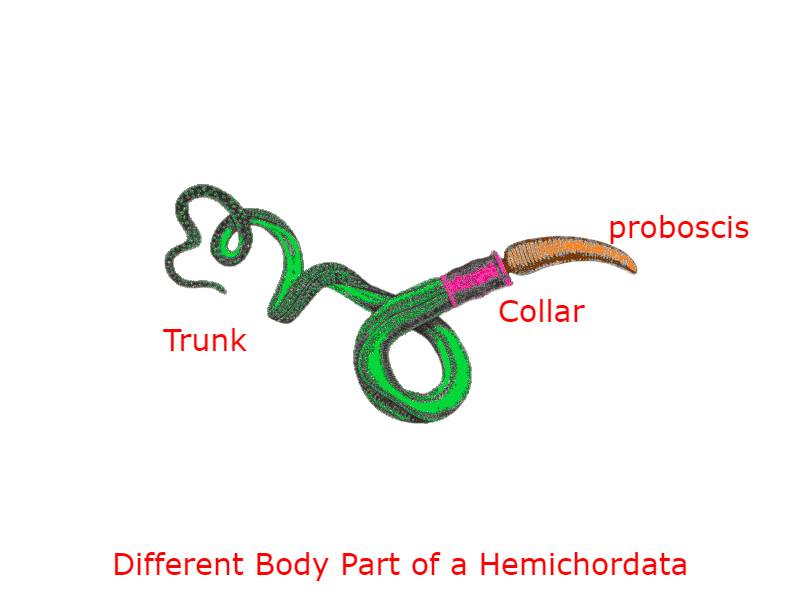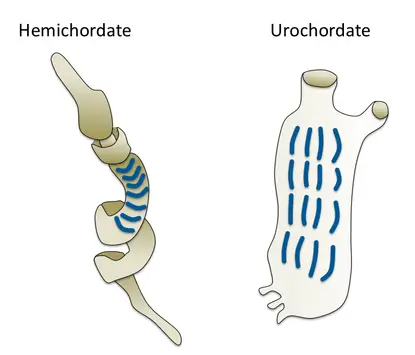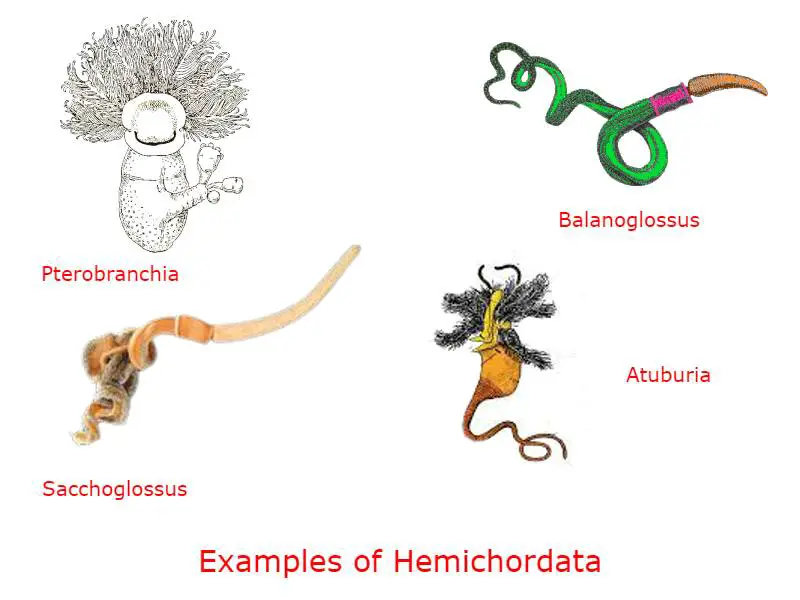Hemichordata include soft-bodied vermiform invertebrates and they are small groups of animals which have around 80 species, subphylum Hemichordata can be divided into several classes based on their characteristics —
Table of Contents
Class.1: Enteropneusta:
The term Enteropneusta is related to Greek words Enteron and Pneusta, the word Enteron refers to gut and the word Pneusta refers to breathing. So the word Enteropneusta refers to those animals who breathe through the gut or alimentary canal.
- Members of Enteropneusta generally live solitarily and generally live in burrows but maybe free swimming.
- Proboscis joined with collar through the proboscis stalk, the proboscis look like acorn or fruit of oak and the genital wings look like ox tongue, for this resemblance members of Enteropneusta also known as acorn worm or tongue worm.
- Body is vermiform and body is covered by smooth glandular skin.
- Proboscis is conical in shape and collar is short cylindrical structure, collar do not have ciliated arms.
- In pharyngeal wall a large number of U shaped gill slits present in pairs which is supported by M shaped branchial skeleton.
- Male and female are separate but sexual dimorphism is absent, gonads present in large number, arranged in longitudinal rows in genital wings.
- Alimentary canal is complete, start at mouth opening and end at terminal anus, alimentary canal is straight.
- Asexual reproduction generally not observed but they have great power of regeneration. Development is indirect and life history have Tornaria larva.
Examples of Class Enteropneusta: Some important members of class Enteropneusta are, Balanoglossus, Spengelia, Ptychodera, Saccoglossus, Protoglossus.

Class:2 Pterobranchia:
The term Pterobranchia is related to two words, Pteron and Branchion, the word Pteron refers to feather, and the word Branchion refers to gill.
- Members of class Pterobranchia can live in colonial form or solitarily, they are sessile and live in the chitinous burrows.
- Body have stalk for attachment to the substratum and body is short and compact.
- Proboscis is shield like and the collar have ciliated arms or lophophore.
- Alimentary canal is complete and U shaped, anus present near the mouth opening dorsally.
- Gill slits is not U shaped and gill slits maybe present one pair or maybe absent.
- Gonads are single or present only one pair, male and female maybe separate or united.
- Asexual reproduction is generally absent in class Pterobranchia but in some cases budding occur.
- Development maybe indirect or direct, in indirect development larva stage present.
Examples of Class Pterobranchia: Some important members of Class Pterobranchia are, Cephalodiscus, Rhabdopleura, Atubaria.

Order:1 Rhabdopleurida:
- They live in colonial form, several zooids are connected to each other through stolon.
- Gill slits are completely absent in order Rhabdopleurida.
- Collar have two ciliated or tentacular arms.
- In Rhabdopleurida gonads are sac like and only a single gonad is present.
Order Rhabdopleurida has only a single genus, Rhabdopleura is the only member of this order.
Order:2 Cephalodiscida:
- They may present in solitary state or may form colony, in colonial form several zooids present together in a gelatinous mass.
- Two Gill slits are present and number of gonas also two in them.
- Collar have a large number of tentaculated arms.
Class:3 Planctosphearoidea:
- They have special larva which shows great similarity with Tornaria larva.
- The larva have rounded shape, transparent and pelagic, small in size.
- This larva have special branched ciliary bands and the alimentary canal is L shaped.

Class:4 Graptolita:
- They represent a primitive Hemichordata and they are now extinct.
- Members of this class were present in large numbers in Ordovician and Silurian period but now they are extinct.
- Fossil Graptolites represent this extinct group of Hemichordata.
- Members of class Graptolia were present in colonial form and they have tubular chitinous skeleton, they show great similarity with Rhabdopleura.
Reference Characteristics Features of Hemichordata
Detailed Information on Characteristics Features of Hemichordata
Hi Everyone!!! Welcome to Imaluop. Imaluop always try to learn some new and he want to share to other people. Here we will try to learn various topics on Science, specially on Biological Sciences.